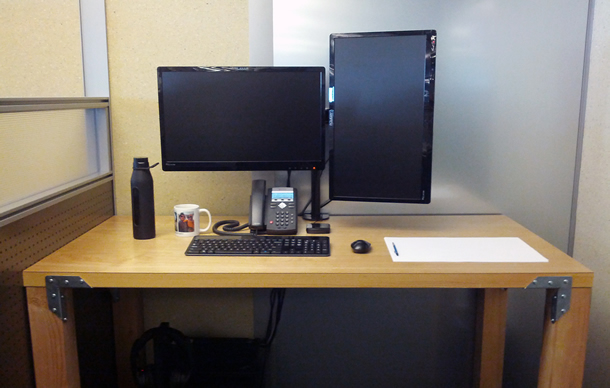
Every day before I leave work, I rinse out my coffee mug and my water bottle. I file any papers that I’m still using and recycle those I’m finished with. I photograph and erase any useful scribblings on my marker board and paste the photographs into my notes. I clean my phone, tablet, and monitors if they are smudged.
I wipe down my keyboard and mouse and straighten the objects that will remain on my desk: water bottle, coffee mug, telephone, keyboard, mouse, and pencil (see Figure 1). My monitors sit above my desk, centered exactly at eye-level—I have measured this, and their cables are neatly tied along the length of their stand. My keyboard and mouse are wireless; all other cabling is hidden behind my filing cabinet, which is where I dock my laptop. There is nothing else in my cubicle. As I leave for the day, I look back at my desk as someone walking by would see it. I admire the gleaming marker board, the starkness of the cubicle organization, and the careful composition of the arranged objects on the desk. It looks like a crazy person works there.
I wasn’t always like this. Rather than describe what my work area used to look like, here’s a story about a dog my sister rescued. When my sister found him he was filthy and covered with pests. She cleaned him up and nursed him back to health. Once he’d regained his strength, he never tolerated dirtiness again, cleaning himself obsessively. In my mind’s eye I see this dog cleaning himself every time I organize my desk.
But what caused this change? How did I get this way? Are things really better now?

In the Beginning
I started my first UX job at a mid-sized independent agency. There was excellent mentorship for a new designer, but the philosophy was a little bit “throw ‘em in the water and see if they can swim.” I was perfectly fine with this at the time because, as a recent college graduate, I thought I knew everything. And after only a little thrashing, I did end up swimming just fine.
Over time, my actions at work began to coagulate into some semblance of routine, but I never took the time to focus on the way I worked. Whatever I was doing was working just fine, and besides, I was too busy to divert energy away from work towards refining my work process.
I know now that I was working in a state of “Continuous Partial Attention,” never disconnecting from communications with other people, either in person or online (see Figure 2). I always had Reddit, Facebook, and my personal email and chat open in a browser window; I opened and responded to work emails as they arrived; I returned fire when attacked with Nerf weapons. Work was something that happened in the space between those interruptions, and only stopped when I was finished, often only a few minutes before I was scheduled to present the work.
Today, things are quite different. I work at Amazon as a UX designer for the sales website. I have been here for four months. When I got to work this morning, I reviewed a list of things to do, selected three of them, and began an “Uninterrupted Focus Block.” At least that’s what I have named it in my calendar appointments. An Uninterrupted Focus Block (UFB) is ninety minutes long because that’s what all the experts say is the ideal amount of time to focus. I don’t check Facebook or email—I don’t even open Outlook until after my first UFB. I put enormous headphones on, mostly to signal my unavailability to coworkers, but also to listen to my UFB music playlist, which supposedly primes my brain to do creative thinking. After ninety minutes, I stop working, no matter how much I’ve done.
Life in Transformation
So why would I change my work behavior so drastically? The main reason is that the creative people that I most admire are regimented in their practice in some way. When thinking about those coworkers and bosses that I respect the most, I see there is very little they do in terms of deliverables or communication that seems haphazard in any way. I do think there is a connection between methodical process and excellent work. Because of my experiences with these people, I associate their regimented practice with experience, maturity, and professionalism.
Because I started a new job four months ago, I had the perfect opportunity to reinvent my professional persona. As someone who changed schools in the fourth, fifth, sixth, and twelfth grades, I can attest to the miracle of social rebirth through environmental change. Nobody at my current job has any idea what a Reddit junkie I was; nobody here has grown accustomed to immediate email responses from me; nobody here knows me as a chronic procrastinator. New surroundings and schedules are a great way to break old habits; this was my chance to change all of that at once.
And even though I was doing fine without any kind of method, I was beginning to suspect that I wasn’t doing my best. Since I’d never worked any other way, I had no basis of comparison for myself. But conventional wisdom suggests that structure is more time and energy efficient than the alternatives. Time and energy are things I value more now than when I first started working, mostly because I have a baby boy at home. I have more incentive to get home before his bedtime, which means I have to get more done while I’m at work. Plus, the chronic sleep deprivation of being a new father has sapped my ability to play catch-up at the last minute.
Given this growing need to reclaim my lost potential and the fact that I was starting a new job, I decided to really dig in and take a look at how I was working.
Help from the Pros
There are numerous books on the subjects of work efficiency and work-life balance. I am wary of these kinds of resources, especially the ones that claim to be able to fix anyone’s problems. I’ve never seen any kind of “system” that is actually able to really work for every person. Rather, true solutions tend to be personal and borrow bits and pieces from multiple systems. To that end, what I’m doing is what is working for me right now. And while I think you can learn from stories of how other people have changed their behaviors, there is no method that can be adopted by multiple people without some personalization.
Most of the books from the bestseller lists are intended for a general audience, whereas the habits of a designer and the demands of creative thinking can be different from other jobs. I tended to look for resources that were as specific as possible to designers, and even to the practice of UX.
The first book I would recommend to someone looking for the same kind of transformation would be Manage Your Day-to-Day from 99U, edited by Jocelyn K. Glei (see Figure 3). It’s a collection of twenty essays from creative industry luminaries on the topics of routine, focus, professionalism, and creativity.

My favorite thing about this book is that it’s unassuming—the editors never claim that their book is a silver bullet with answers for every person. Rather, the book describes a variety of tools and techniques that successful creative people have developed over their careers. Some of the essays even seem to contradict one another at times, but the book is more like a sampler of ideas; readers are invited to explore further if something resonates with them. It’s a great starting point if you’re interested in changing how you work.
So How’s It Going?
The editor of this article will be the first to tell you that my time management skills still need work, but for the most part I’m sticking to my new habits. The experts will tell you that interrupting a focused block of time means starting over, that you have to jettison any remaining time and go directly to your break; I fudge on this recommendation. After three years of perpetual interruption, I feel like my brain can handle small blows to focus; besides, inaction in the face of Nerf aggression is a sign of weakness.
So much of what I’m learning is simply how to be a grown-up. Honestly, I have no idea how I’ve survived as long as I have without learning the practical matters of organization. And while my organization and focus have improved, I can’t say I’ve seen a marked increase in the quality of my work. I can say that I am more in control of my schedule, and, in the long term, this should have a positive effect on my work as I am more able to do non-critical things that can help me hone my design skills.
The control I feel also allows me to be a more professional designer—I can give project managers more accurate and confident estimates, for example. And while I used to think that the spontaneity of my previous process was good for inspiration, I find that the predictability and consistency of my current process is actually far more freeing. Of course the brain needs some time away from creative tasks to refocus, but that time is now scheduled into my day, rather than peppered randomly throughout.
I take courage from the words of Chuck Close: “Inspiration is for amateurs. The rest of us just show up and get to work.” Speaking of which, my focus block is about to end.学会高效管理自己每天的工作有众多好处。这是我的亲身经历,以前我工作时总是处于走神状态,后来采用不间断专注等策略提高了工作效率。我曾经以为我从前的即兴式工作流程能有效激发灵感,但我发现当前工作流程的可预见性和一致性更能摆脱心灵的束缚。
文章全文为英文版작업 시간을 효율적으로 관리하는 법을 배우면 여러 가지 이득이 있습니다. 지속적 부분 집중 상태로 작업하기부터 연속된 집중 단위 같은 생산성 전략 사용에 이르기까지, 내가 작업 방식을 어떻게 바꿨는지에 대한 이야기가 소개됩니다. 나는 예전 과정의 자발성이 영감에 좋다고 생각하곤 했지만, 지금의 작업 과정이 갖는 예측 가능성과 일관성이 훨씬 해방감을 준다는 것을 알게 되었습니다.
전체 기사는 영어로만 제공됩니다.Existem diversas vantagens em aprender como gerenciar o dia de trabalho de maneira eficiente. Esta é a história sobre como transformei minha forma de trabalhar de um estado de Atenção Parcial Contínua para o uso de estratégias de produtividade como Blocos de Foco Ininterruptos. Embora pensasse que a espontaneidade do meu processo anterior fosse boa para a inspiração, descobri que a previsibilidade e a consistência do meu processo atual são muito mais libertadoras.
O artigo completo está disponível somente em inglês.仕事をする日を効率的に管理する方法を学ぶことにはいくつかのメリットがある。これは、継続的な部分注意型の仕事のやり方から、中断のないのまとまった集中時間をとるといった生産性向上のストラテジーの利用へと、私がどう変化を遂げたかについて語ったストーリーである。私は、これまでに行っていた自発的なプロセスがインスピレーションのためには良いと以前は思っていたのだが、対象としているプロセスが持つ予測の可能性や一貫性のほうが、はるかに多くの解放感を与えてくれるものだとわかった。
原文は英語だけになりますAprender a manejar eficientemente el día de trabajo rinde muchos beneficios. Aquí les presento mi historia sobre cómo pasé de trabajar en un estado de atención parcial continua a utilizar estrategias de productividad como los bloques de enfoque ininterrumpido. Si bien yo pensaba que la espontaneidad de mi proceso anterior era buena para la inspiración, he notado que la predictibilidad y la consistencia de mi proceso actual son muchísimo más liberadores.
La versión completa de este artículo está sólo disponible en inglés.
